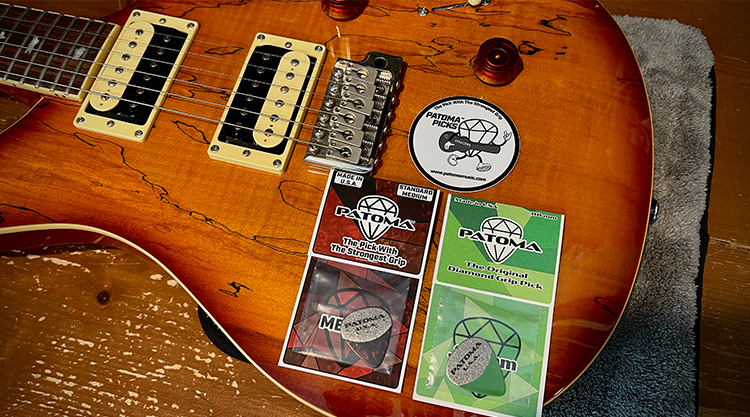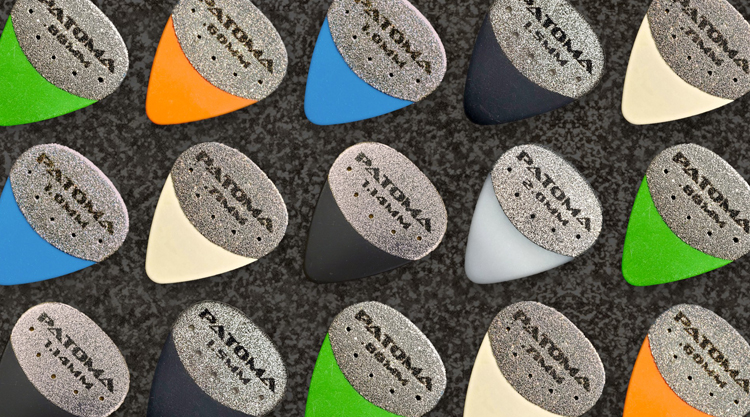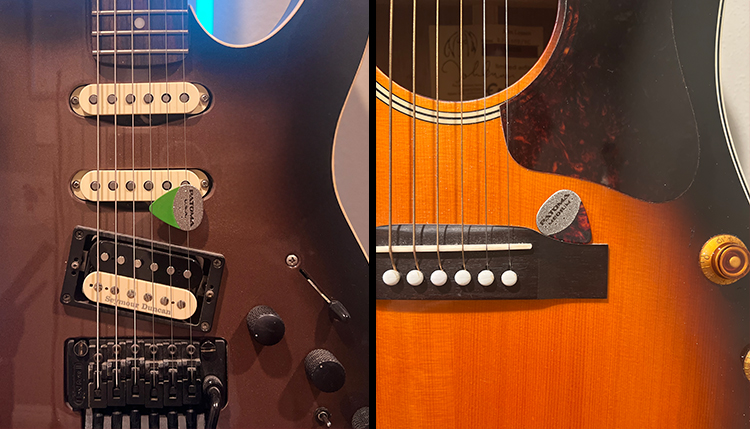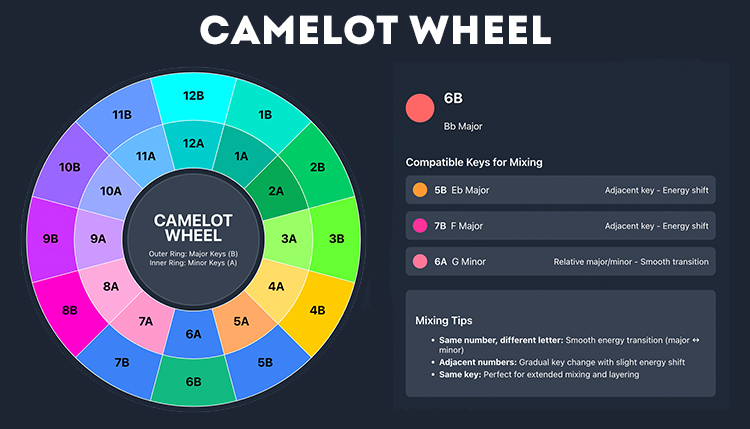Ever lost a killer guitar solo because your pick slipped through your fingers at the worst possible moment? You’re not alone.
Guitar forums across the internet are filled with the same recurring question: ‘How do I stop my pick from slipping during performances?‘ It’s a problem as old as the instrument itself.
That’s where Patoma Picks revolutionary diamond-plated guitar picks enter the scene, promising to solve what has been a persistent headache for guitarists since, well, forever.
As a long-time guitarist who’s gone through thousands of picks (and lost most of them to the mysterious black hole that all guitar picks eventually disappear into), I was skeptical but intrigued when Patoma reached out for a review.
Could these American-made, diamond-plated picks really deliver on their bold promise to never slip from your hands?
After a few weeks of testing across different playing styles, guitars, and environments, I’m ready to share my comprehensive findings on what might be the most innovative advancement in guitar pick technology in decades.
- Diamond-plated technology provides unmatched grip that literally feels “sticky” without being uncomfortable
- Handcrafted in New Jersey using a meticulous 8-hour patented process
- Available in multiple shapes, materials, and thicknesses to suit different playing styles
- Priced at a premium but potentially worth it for serious players
- May be game-changing for guitarists with arthritis or grip issues
Patoma Pick Finder
The Origin Story of Patoma Music
Every great innovation has an equally fascinating origin story, and Patoma’s diamond-plated picks are no exception. It all started with teenage frustration—something we can all relate to.
Nick Tomasi began playing guitar at the age of 7 and by his teens had already amassed an impressive collection of over 30 guitars. That’s some serious dedication right there.
Like most of us guitarists, he faced the age-old problem of picks slipping through his fingers during intense playing sessions.
The eureka moment came when Nick was caught by his father, Mario, scratching up his picks with a knife—a DIY hack many guitarists resort to for better grip.
Mario’s reaction wasn’t just parental concern about sharp objects. It was an invitation to innovation: “Come on, Nicholas, you’re going to find a better way to do this.”
Talk about being in the right place at the right time. Mario happened to work in an industrial diamond workshop specializing in diamond-plated cutting wheels.
That connection sparked a genuine light-bulb moment for young Nick. Why not apply the same diamond-plating technology to guitar picks?
What followed was a year of intense testing and experimentation. Not overnight success, but persistent refinement.
At just 17 years old, Nick successfully created and patented the world’s first diamond-plated guitar pick—a testament to youthful innovation meeting practical need.
The name “Patoma” itself tells another chapter of the story, cleverly combining the last names of the founding partners Patalano and Tomasi. It’s not just a catchy brand name; it’s a reflection of the collaborative spirit behind the company.
Nick recognized he needed business expertise to complement his innovation, so he partnered with John Patalano Jr. to help establish and grow the business.
November 2023 marked the official launch of Patoma Music, with John Patalano Sr. joining the founding team to bring decades of business experience to the table.
The company remains proudly American, with all picks handcrafted at their New Jersey workshop. There’s something refreshingly authentic about knowing exactly where your gear comes from.
Their commitment to American craftsmanship isn’t just patriotic marketing—it allows for meticulous quality control through every step of their patented 8-hour manufacturing process.
Each pick contains approximately one carat of natural diamond, carefully applied to create that signature grip that doesn’t quit.
What strikes me most about Patoma’s story is how it embodies the classic American dream narrative: identify a problem, innovate a solution, patent it, build a business around it.
From a teenager modifying picks with a knife to creating a potentially game-changing product for musicians worldwide—that’s the kind of story that resonates beyond just the product specs.
- Founded by young innovator Nick Tomasi who patented the design at age 17
- Name “Patoma” combines founding partners’ last names (Patalano and Tomasi)
- All picks handcrafted in New Jersey through patented 8-hour process
- Launched officially in November 2023 with three founding members
- Company built around solving a real problem experienced by guitarists worldwide
For musicians who value both innovation and craftsmanship, the origin story adds an extra dimension to the product. You’re not just buying another pick; you’re buying into years of problem-solving, experimentation, and passion for improving the playing experience.
That backstory of persistent innovation makes these picks feel less like a mere accessory and more like a meaningful advancement in guitar technology.
Diamond-Plated Technology: How It Works
Let’s get into the nitty-gritty of what makes these picks so special—the diamond-plated technology that sets Patoma apart from every other pick manufacturer out there.
This isn’t just some marketing gimmick or fancy name; it’s legitimate industrial technology applied to solve a musical problem.
Each Patoma pick undergoes an extensive 8-hour patented handcrafting process. That’s right—eight hours to make a single guitar pick.
Compare that to the seconds it takes to mass-produce conventional picks, and you start to understand the premium positioning.
During this painstaking process, approximately one carat of natural diamond is permanently bonded to the pick’s surface.
But why diamond? During their development phase, the Patoma team experimented with numerous materials for creating a non-slip surface.
According to their findings, nothing even came close to the performance of natural diamond.
As one of the hardest and most abrasive materials known to mankind, diamond creates a microscopically textured surface that provides unprecedented grip without compromising the pick’s playing characteristics.
The science behind it makes perfect sense when you think about it. Diamonds have been used in industrial applications for years because of their unparalleled hardness and ability to maintain a textured surface even under extreme conditions.
When applied to a guitar pick, this creates thousands of microscopic contact points between your fingertips and the pick, dramatically increasing friction and preventing slippage.
What’s particularly clever about the implementation is that despite the “grippy” nature of the diamond surface, it doesn’t feel uncomfortable or abrasive against your skin.
It’s not like holding sandpaper—it’s more like the pick develops an almost magnetic relationship with your fingers. You need significantly less grip pressure to maintain control, which translates to reduced hand fatigue during extended playing sessions.
Traditional methods guitarists have used to improve pick grip include drilling holes, using picks with raised logos or textures, applying grip enhancers like Gorilla Snot (yes, that’s a real product), or manually roughing up the surface with sandpaper or other abrasives.
While these methods provide temporary improvements, they typically wear down quickly or create inconsistent results.
The diamond plating, by contrast, is permanent and uniform across the pick’s surface. It doesn’t wear away after hours of playing, doesn’t require reapplication, and provides consistent performance regardless of how sweaty your hands get during that blistering solo.
From a manufacturing perspective, the process is quite intensive.
The base pick material—either Delrin® or Celluloid—is first precisely shaped and then undergoes the proprietary diamond-plating process.
This isn’t simply gluing diamond dust to the surface; it’s a sophisticated bonding technique that ensures the diamonds become an integral part of the pick’s structure.
- Utilizes approximately one carat of natural diamond per pick
- Diamond creates thousands of microscopic contact points with fingers
- Requires significantly less grip pressure than conventional picks
- Diamond was chosen after testing numerous alternative materials
- Proprietary bonding technique ensures durability of the diamond surface
The technology represents a genuine innovation in pick design, addressing a problem that has plagued guitarists for generations.
While other manufacturers have attempted to improve grip through various means, none have taken such a scientific, materials-based approach to solving the problem.
It’s this commitment to finding the ultimate solution—rather than a merely adequate one—that makes the diamond-plated technology so impressive.
For guitarists serious about their craft, the technological advantage translated to real-world performance benefits could very well justify the premium price point and position these picks as essential equipment rather than disposable accessories.
Product Range and Options
Patoma doesn’t believe in a one-size-fits-all approach to guitar picks, and their diverse product range reflects that philosophy.
They’ve developed a comprehensive lineup that caters to virtually every playing style, preference, and musical genre—all while maintaining their signature diamond-plated grip technology across the board.
The product line splits into two main categories based on material: Delrin® and Celluloid.
These weren’t chosen randomly; each material offers distinct tonal characteristics and feel that appeal to different playing styles.
The Delrin Line
Delrin® picks produce a brighter, more articulate tone with excellent durability, making them ideal for precision playing and genres requiring clear note definition.
They are available in standard and sharp and follow a color-coding system with each thickness assigned a specific color:
- .73mm (yellow)
- .60mm (orange)
- .50mm (red)
- .88mm (green)
- 1.0mm (blue)
- 1.14mm (purple)
- 1.5mm (black)
- 2.0mm (white)
The Celluloid Line
Celluloid picks, on the other hand, deliver that warm, vintage tone many players crave.
They have a slightly more flexible feel and produce a rounder, more mellow sound that works beautifully for strumming and rhythm playing.
The Celluloid line comes in four traditional gauges:
- Thin
- Medium
- Heavy
- X-Heavy
Old-school players who cut their teeth on classic celluloid picks but struggled with grip issues now have the best of both worlds—vintage tone with modern grip technology.
Shape variations add another dimension to the selection process.
The Standard shape follows the classic 351 design that guitarists have been familiar with for decades—a comfortable, versatile shape that works well for most playing styles.
For those needing more precision for lead work or complex picking patterns, the Sharp model features a more pointed tip that allows for greater accuracy when targeting individual strings.
Color options serve both aesthetic and practical purposes.
Beyond looking cool, the different colors help players quickly identify their preferred thickness in a dark venue or during quick pick changes mid-performance.
Pricing reflects the premium positioning of these picks, with individual Delrin® picks costing $9.99.
For those wanting to experiment with different options, Patoma offers curated Variety 3-Packs that group similar gauges together—a smart way to find your perfect match without committing to a single option.
When compared to standard picks that typically cost between $0.25 and $1.00 each, Patoma picks definitely represent a significant investment. However, the comparison isn’t entirely fair—it’s like comparing a hand-crafted chef’s knife to a disposable plastic one.
They’re serving the same basic function but offering dramatically different performance characteristics.
- Two primary materials: Delrin® for brightness/precision and Celluloid for warmth/vintage tone
- Thickness options in Delrin® ranging from ultra-thin .50mm to substantial 2.0mm
- Two shape options: Standard (traditional 351) and Sharp (pointed tip for precision)
- Color-coded system makes identifying different thicknesses intuitive
- Variety 3-Packs available for those wanting to experiment with different options
The thoughtfulness behind the product range demonstrates Patoma’s deep understanding of guitarists’ needs.
Rather than creating a single “miracle” pick, they’ve developed an ecosystem of options that respect player preferences while solving the universal problem of grip.
This approach acknowledges the highly personal nature of pick selection—what works perfectly for a heavy metal shredder might be completely unsuitable for a fingerstyle acoustic player.
For guitarists accustomed to buying picks by the dozen and accepting their disposable nature, the Patoma approach represents a paradigm shift—treating picks as precision tools worthy of investment rather than cheap consumables.
Whether this shift resonates with the broader guitar community remains to be seen, but the comprehensive product range certainly provides compelling options for those ready to upgrade their picking experience.
Performance Testing: Playability and Sound
Let’s cut to the chase—how do these diamond-studded beauties actually perform when the rubber meets the road (or more accurately, when the pick meets the string)?
First impressions matter, and the moment you hold a Patoma pick, you notice the difference.
There’s an immediate tactile sensation that’s hard to describe—not rough or abrasive as you might expect, but almost magnetically “clingy” to your fingertips.
You can actually reduce your grip pressure significantly and still maintain perfect control.
I rotated through two models, the Delrin® Standard in .88mm (green), and the Celluloid Standard in Medium.
The Delrin® Standard excels at versatility. Whether strumming acoustic rhythm parts or digging into electric lead lines, it maintains consistent tone and feel.
The diamond grip truly shines during fast alternate picking passages where traditional picks often begin to shift or rotate slightly in your grip.
The Patoma pick stayed locked in position, allowing for greater speed and accuracy without the unconscious adjustment of grip that typically happens with standard picks.
The .88mm thickness hits a sweet spot between flexibility and rigidity, offering enough give for comfortable strumming while maintaining the stiffness needed for precise single-note lines.
The diamond plating improved grip allows you to focus more on your playing technique rather than compensating for a slipping pick.
The Celluloid model delivers exactly what you’d want from a celluloid pick—warm, rounded tone with a vintage character that works beautifully for blues, classic rock, and rootsy acoustic styles.
The slightly more flexible nature of celluloid compared to Delrin® creates a softer attack that flatters strummed chords and arpeggios.
Jazz chord melody players and classical-influenced guitarists will particularly appreciate this combination of precision and grip stability.
One unexpected benefit I noticed while testing—the reduced grip pressure needed translated to more relaxed hand position and consequently more fluid playing.
Many guitarists unconsciously grip their picks too tightly, creating tension that can impede technique and even contribute to repetitive strain issues over time.
The Patoma picks’ secure grip encourages a more relaxed, efficient approach to picking.
One curious adjustment I noticed was breaking the habit of constantly repositioning the pick between phrases—a fidgety behavior I think most guitarists develop unconsciously with standard picks.
The Patoma pick’s enhanced grip actually prevents this habitual micro-adjustment, which feels strange at first but ultimately leads to more consistent attack and improved efficiency once you adapt to the change.
After numerous A/B comparisons with standard picks of the same thickness and material, the performance advantages of the Patoma picks became increasingly evident.
While the tonal differences are subtle, the playability improvements are substantial—and in real-world playing situations, the ability to maintain consistent technique without fighting a slipping pick makes a meaningful difference to your overall sound and performance.
| Feature | Benefit |
|---|---|
| Diamond-Plated Grip | Real diamond coating delivers unmatched, slip-free hold-even for sweaty hands or intense playing. |
| Superior Control | Patented grip feels like it sticks to your fingers, boosting confidence and precision. |
| Reduced Grip Pressure | Requires less force to hold, ideal for players with grip issues, nerve damage, or arthritis. |
| Handcrafted in the USA | Each pick undergoes an 8-hour handcrafting process for premium quality. |
| Variety of Shapes & Gauges | Available in multiple thicknesses (0.6mm–2.0mm) and shapes (“Original” and “Sharp”) to suit any style. |
| Color-Coded Options | Different thicknesses come in distinctive colors for easy selection. |
Grip Performance Under Various Conditions
The true test of any grip-enhanced pick isn’t how it performs when your hands are clean and dry in an air-conditioned studio—it’s how it holds up when things get real.
Let’s start with the baseline—normal, dry playing conditions.
In this scenario, the Patoma picks already demonstrate significant grip advantages over standard picks, requiring noticeably less pressure to maintain a secure hold.
You can actually hold the pick with a feather-light touch between your thumb and index finger and still maintain complete control, something practically impossible with conventional picks.
But the real differentiation becomes apparent when the sweat starts flowing.
This would normally be the death zone for pick grip, the point where I’d be constantly readjusting or switching to a fresh pick for better traction.
The microscopic diamond texture actually seems to work better with a small amount of moisture, creating an almost suction-like connection with your skin.
This is where the scientific approach to grip really pays dividends—while even the best-textured conventional picks become slippery when wet, the diamond plating actually maintains its traction.
I wanted to do a little test so I washed my hands without fully drying them and applied some hand lotion (a notorious pick-grip killer).
While the grip was somewhat reduced compared to ideal conditions, it still outperformed regular picks by a significant margin.
It’s not magic—extreme moisture will still affect performance—but the threshold at which the pick becomes unplayable is much higher than with standard options.
For guitarists who suffer from hyperhidrosis (excessive sweating) or those who regularly perform under hot stage lights, this performance characteristic alone could be worth the price of admission.
Being able to focus on your playing rather than constantly fighting a slipping pick can make a tremendous difference in both technique and confidence on stage.
Compared to other grip-enhanced picks on the market—including those with rubberized surfaces, textured patterns, or holes—the Patoma picks demonstrated superior performance across all test conditions.
- Maintains grip integrity even with noticeably sweaty hands
- Performs better with slight moisture than bone-dry conditions
- Requires significantly less grip pressure than conventional picks
- Remains playable even after hand washing or light lotion application
- Potential game-changer for players with arthritis or neurological issues affecting grip
Most competing solutions either offer less effective grip to begin with or rapidly deteriorate in grip performance as playing conditions become more challenging.
One interesting observation: there seems to be an adaptation period where your playing technique subtly adjusts to the enhanced grip.
Initially, you might actually over-control the pick, as your muscle memory is accustomed to compensating for the expected slippage that never comes.
After a few hours of playing, though, you naturally relax into a more efficient technique that takes advantage of the improved stability.
For working musicians who perform regularly in challenging environments—hot clubs, outdoor summer festivals, high-energy genres that induce sweating—the performance benefits under adverse conditions might be the most compelling selling point of these picks.
The confidence of knowing your pick won’t betray you mid-solo allows for greater focus on musicality and expression rather than technical compensation.
Durability and Longevity
Let’s talk about the elephant in the room—at $9.99 per pick, Patoma’s offerings represent a significant investment compared to standard picks.
The natural question becomes: are they built to last, or will you be replacing these premium picks just as often as their budget counterparts?
Most guitarists are accustomed to picks as consumable items that wear down, warp, crack, or simply disappear into the mysterious void that has claimed countless picks throughout history.
The Patoma picks are clearly designed with longevity in mind, starting with their choice of base materials.
The Delrin® models in particular demonstrate excellent wear resistance, showing minimal signs of edge wear even after hours of aggressive playing.
The playing tip maintained its definition without developing the rounded edges that typically occur with conventional picks.
The Celluloid models, consistent with the nature of the material, showed more noticeable wear than their Delrin® counterparts.
The playing edges began to show slight rounding after several hours of use, particularly with aggressive strumming techniques.
However, even with visible wear, they continued to perform well and maintained their tonal characteristics.
For players who prefer celluloid’s vintage tone and feel, the slightly reduced longevity compared to Delrin® models may be an acceptable trade-off.
Most importantly, the diamond-plated grip surface showed remarkable resilience throughout testing.
Even after extensive use, the distinctive grippy sensation remained consistent, with no noticeable reduction in traction.
This is particularly impressive considering that most textured or grip-enhanced picks tend to smooth out over time, gradually losing their grip advantage.
Patoma recommends a simple cleaning process to maintain optimal performance: applying a small amount of dish soap to a toothbrush, gently scrubbing the grip surface, rinsing with warm water, and drying with a soft cloth.
After cleaning, the grip performance returns to like-new condition.
- Delrin® models show exceptional resistance to tip wear and edge deformation
- Diamond grip surface maintains consistent performance even after extensive use
- Cleaning with dish soap and toothbrush effectively restores original grip quality
- Celluloid models wear somewhat faster but still outperform standard celluloid picks
- No visible degradation of the diamond plating even after aggressive playing
From a value perspective, these picks present an interesting proposition. While the upfront cost is significantly higher than standard picks, their extended lifespan potentially offsets this premium over time.
Based on my testing, a single Patoma Delrin® pick could easily outlast a dozen or more conventional picks of similar thickness.
For players who typically burn through picks quickly due to aggressive playing styles, the economics become even more favorable.
There’s also the important factor of pick loss to consider. The significant investment in a Patoma pick naturally encourages more careful handling and storage.
I found myself being much more deliberate about keeping track of these picks between playing sessions, treating them more like valuable tools than disposable items.
One longer-term consideration that couldn’t be fully assessed during the testing period is how the diamond plating might wear after months or years of use.
However, given that industrial diamond coatings are designed for much more abrasive applications than guitar playing, there’s reason to believe the grip performance would maintain integrity over an extended lifespan.
For professional musicians who depend on consistent performance night after night, the durability of Patoma picks translates to reliability—a quality that’s difficult to put a price tag on when you’re on stage.
The confidence of knowing your equipment won’t fail at a critical moment has intangible value beyond the simple economics of replacement costs.
Benefits & Considerations
After thoroughly testing these diamond-plated wonders across various playing conditions, guitars, and musical styles, it’s time to lay out the clear advantages and potential drawbacks of Patoma’s innovative picks.
No product is perfect for everyone, and an honest assessment helps guitarists determine if these premium picks align with their specific needs and preferences.
Let’s start with the undeniable strengths. The diamond-plated grip technology genuinely delivers on its primary promise—these picks simply don’t slip, even under challenging conditions.
That’s not marketing hyperbole; it’s a functional reality that translates to improved playing confidence and technique.
The grip performance remains consistent regardless of how sweaty your hands get, a massive advantage for performers under hot stage lights or guitarists who naturally have damper hands.
The craftsmanship and material quality are immediately apparent. These aren’t mass-produced in massive quantities; each pick undergoes an 8-hour patented process resulting in a precision tool rather than a disposable accessory.
The attention to detail extends to the clean edges, consistent thickness, and overall quality feel that separates these picks from standard options.
The comprehensive range of options deserves praise. By offering multiple materials (Delrin® and Celluloid), shapes (Standard and Sharp), and thicknesses (from .50mm to 2.0mm), Patoma ensures that virtually any guitarist can find their ideal match without compromising on grip quality.
This demonstrates a genuine understanding of how personal pick choice can be for serious players.
Ergonomic benefits emerged as an unexpected strength during testing. The reduced grip pressure required not only prevents fatigue during extended playing but could be genuinely beneficial for guitarists with physical limitations like arthritis, nerve damage, or grip issues.
The durability of these picks, particularly the Delrin® models, presents long-term value despite the higher initial investment.
When a single pick potentially outlasts dozens of conventional alternatives, the price premium becomes more justifiable, especially for serious players who practice or perform regularly.
Now for the considerations that might give some guitarists pause. The most obvious is the price point—at $9.99 per pick, these represent a significant departure from the typical pick purchasing mindset.
For casual players who view picks as inherently disposable items, this may be a difficult psychological barrier to overcome.
There’s definitely an adaptation period required. If you’ve played for years with standard picks, your technique has unconsciously developed to compensate for the typical slippage and grip issues.
When first using Patoma picks, you might initially feel like you’re over-controlling the pick until your playing adjusts to the enhanced stability. This isn’t necessarily a negative, but it does require some patience during transition.
Finally, availability might be a consideration for some. As a relatively new company with handcrafted products, Patoma doesn’t yet have the widespread distribution of major pick manufacturers.
While online ordering is seamless with flat-rate shipping, the ability to grab replacements locally before a gig isn’t currently an option in most areas.
Benefits
- Unmatched grip performance even with sweaty hands
- Superior durability
- Exceptional craftsmanship and material quality
- Comprehensive range of options for different playing styles
- Potential benefits for players with arthritis or grip limitations
Considerations
- Premium price point requires shift in how picks are valued
- Brief adaptation period for players accustomed to standard picks
- Limited availability compared to mass-market competitors
The ideal Patoma pick player is likely a serious guitarist who practices or performs regularly, values consistent performance over bargain prices, and has experienced frustration with picks slipping during critical moments.
Professional musicians, recording artists, and dedicated hobbyists who view their instruments and accessories as investments rather than disposables will find the most value in these premium picks.
For casual players who practice occasionally or those on tight budgets, the value proposition becomes more questionable.
However, even for these players, having one or two Patoma picks for important performances or recording sessions could be worthwhile, even if standard picks remain their daily drivers.
Final Verdict and Recommendations
After testing across multiple scenarios, musical styles, and playing conditions, the verdict is clear: Patoma’s diamond-plated guitar picks deliver on their core promise of providing unmatched grip that transforms the playing experience.
These aren’t merely incremental improvements over standard picks; they represent a fundamental rethinking of what a guitar pick can be—elevating it from disposable plastic to precision tool status.
Overall, I’d rate these picks 9/10—not perfect (what is?), but genuinely innovative and potentially game-changing for the right players.
The one-point deduction primarily relates to the premium price positioning, which, while justified by the technology and craftsmanship, will inevitably limit accessibility for some players.
For specific playing styles and preferences, certain Patoma models stand out as particularly recommended.
Heavy strummers and rhythm guitarists will find excellent results with the Celluloid Standard in Medium or Heavy gauges.
The warm, vintage tone combined with rock-solid grip creates a winning combination for acoustic singer-songwriters, classic rock players, and anyone prioritizing rich, full strumming sounds.
The slight flexibility of these models provides natural compression that flatters chord work.
Technical lead players and shredders should gravitate toward the Delrin® Sharp in the 1.0mm to 1.5mm range.
These picks offer the precision and control needed for complex lead techniques while providing enough substance for powerful attack.
The pointed tip allows for clean articulation of fast passages, while the diamond grip ensures the pick stays precisely positioned even during the most demanding sequences.
Jazz and fusion players would be well-served by the Delrin® Standard in heavier gauges (1.14mm to 2.0mm).
These thicker picks produce the warm, rounded tone preferred in jazz contexts while offering the control needed for complex chord melodies and single-note lines.
The standard shape provides versatility for different techniques within these sophisticated genres.
Beginners and developing players represent an interesting case.
While the premium price might seem excessive for newcomers, the improved grip could actually accelerate technical development by removing one common obstacle to clean playing.
For committed beginners with the budget, starting with a quality tool like a Patoma pick might prevent the formation of compensatory bad habits that come from fighting slippery picks.
After a few weeks of use, reaching for standard picks began to feel like a downgrade, a testament to how quickly one can adapt to the improved performance.
In terms of value, these picks certainly deliver on their marketing promises.
The grip technology works exactly as advertised, the craftsmanship is impeccable, and the durability (particularly of the Delrin® models) helps offset the higher initial investment.
For serious players, the performance benefits likely justify the premium pricing, especially when considering the extended lifespan compared to conventional picks.
- Celluloid Standard (Medium/Heavy): Ideal for strummers and rhythm guitarists
- Delrin® Sharp (1.0-1.5mm): Perfect for technical lead players and shredders
- Delrin® Standard (1.14-2.0mm): Excellent choice for jazz and fusion guitarists
- Best overall value: Delrin® Standard 1.14mm for versatility across styles
- Consider variety packs to find your personal favorite before committing
For those interested in trying Patoma picks for themselves, their online store offers direct purchasing with flat-rate shipping ($1.00 domestic for pick orders, $5.00 international).
The variety 3-packs provide an excellent entry point for first-time buyers, allowing experimentation with different thicknesses to find your ideal match.
While discount codes aren’t regularly available, the company occasionally offers promotions through their social media channels.
The company also deserves recognition for their support of worthy causes like Guitars 4 Vets, a non-profit that provides guitars and lessons to veterans dealing with PTSD and other service-related challenges.
Knowing your purchase supports American craftsmanship and contributes to positive social impact adds an intangible but meaningful dimension to the value proposition.
For players constantly frustrated by picks slipping during crucial moments, those with physical limitations affecting grip, or serious musicians seeking every possible advantage in their equipment chain, Patoma picks represent a worthwhile investment that could genuinely transform your playing experience.
While the price of admission is higher than conventional picks, the performance benefits make a compelling case for those ready to view their picks as precision tools rather than disposable accessories.



















